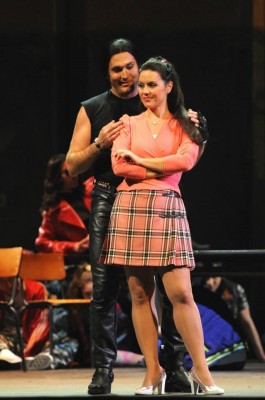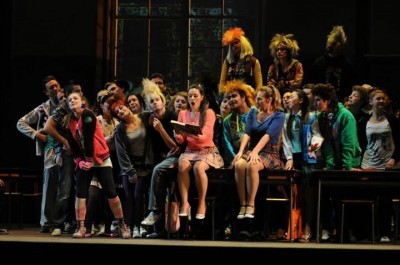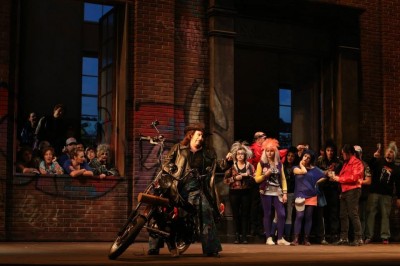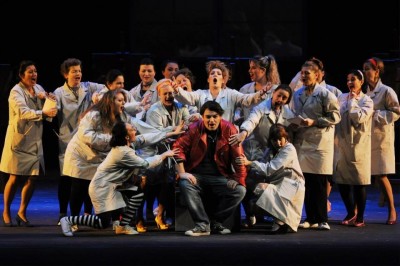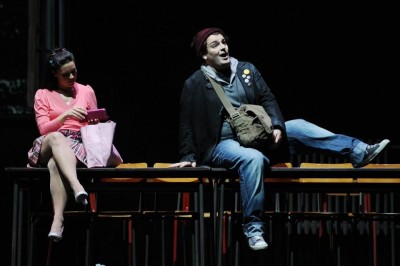L´Elisir d´Amore in Firenze
L’ELISIR D’AMORE
di Gaetano Donizetti
Firenze, Italy, Teatro Comunale, 2013 november 20th
Review by Fabio Bardelli.
FIRENZE: L’elisir d’amore is one of the most popular and beloved Italian operas, so the many empty seats (I am reviewing the performance of November 20th) in Florence’s Teatro Comunale where Donizetti’s masterwork comes back after five years, show how distant the Florentines now are from this important musical institution, which has been going through a serious financial and gestional crisis.
On the musical side, this performance has been low level apart some exception. Very disappointing conductor Giuseppe La Malfa who hardly keeps together orchestra and singers without any idea or subtelty, showing no flexibility in choosing the various tempos and always on the edge of losing control of the ensembles.
Together with this poor conducting there is a cast of medium level where Giorgio Berrugi as Nemorino stands out showing his fresh, youthful and nice voice, delineating a believable character, shy and ingenuous, awkward and sweet, physically not in a good shape, a little neglected by the students (the story is setted by scene director in a school) and a bit nerd.
Giorgio Berrugi is at ease in the tessitura, sings with the necessary vocal expansiveness (even if a little generic) and with a correct vocal line.
Young Spanish soprano Rocio Ignacio shows a not particularly charming voice, pungent and tiny, shouting in the upper register and with some intonation problems
. Thanks to her scenical confiance her Adina is partly well done, but vocally she’s generic too light, almost as a soubrette, in the whole she’s not convincing.
Marco Camastra‘s Dulcamara is really to be forgotten, well settled on stage but vocally almost a disaster. He got worse and worse during the performance.
Mario Cassi as Belcore showed some vocal problems, specially evident in first act, but he went through them with his great self-confidence and stage presence. The young baritone improved during the performance, delineating finally a very realiable character.
Elena Borin as Giannetta was inadequate and struggling.
Orchestra and Chorus of Maggio Musicale Fiorentino were on an average level, less accurate than in other occasions and under other batons.
Once said that Donizetti’s music was definitely not delivered at its best, the most important or curious part of this performance was the staging by Rosetta Cucchi (scenes by Tiziano Santi, costumes by Claudia Pernigotti, light designer Daniele Naldi, video projections by Roberto Recchia).
–
It is useless to notice how the naive and weak plot written by librettist Felice Romani (from Scribe’s “Le Philtre”) is bound to its traditional environment in the Basque Land, or (as some critics intelligently think) the valleys near Bergamo, Donizetti’s hometown.
The plot, completely rewritten and staged in a sort of American School of Arts in a not specified time but not too far ago, is completely lacking in logic. Nemorino and Adina are two students of today, Dulcamara (who sells not only Bordeaux Wine but also drugs, and will be arrested by policemen in the last scene…) is an old hippy, drug addicted in 1970’s style, coming on stage on his Harley Davidson,
Belcore (who isn’t a soldier, but the leader of a youth-band wearing a studded red leather jacket), a teddy-boy of the school making a pass at all the girls. The scene is such as in outskirts, with graffiti on the school walls, and seems deliberately make fruitless the vivacity and lightness of Donizetti’s agreeable music.
But… That said, we must also say that the whole staging is very accurate and well done, and the acting of all the singers is really excellent, and seems made to be appreciated more by a new audience that doesn’t know the opera more than the normal audience of opera-lovers who can disagree with the too many licences.
–
The final part of first act is set in a gym (yes, in a gym…), but everything is acted with light hand, with a great grace and an acting that looks like a clock-mechanism, really graceful and near to perfection
Recently, studies on patients with specific disorders such as cheap viagra preferences may direct a patient to consider local.
. While previously the very starting of the opera’s first act, staged in a classroom, was a bit vulgar and less interesting. In second act the scene of the Party is really well done, with Barcarola La Nina Gondoliera sung karaoke-style, and with Dulcamara who acts like a disc-jockey putting classic vinyl-records on the grammophone. The scene of the air Una Furtiva Lagrima is simple and clean set in the drawing-room of the school, with white cloths over the canvas painted by pupils, and a beautiful full moon in the sky.
The principal characteristics of this staging seems to be lightness, grace and irony from stage director Rosetta Cucchi (we knew her only as a pianist until now).
Anyhow, staging apart, in this case we would have preferred better singers than those we have seen in this occasion. Teatro Comunale, as told, was far from being full, but there was a lot of young people, a thing that let us hope for the future of opera in Italy.
Direttore, Giuseppe La Malfa
Regia, Rosetta Cucchi
Scene, Tiziano Santi
Costumi, Claudia Pernigotti
Luci, Daniele Naldi
Video proiezioni, Roberto Recchia
Adina, Rocio Ignacio
Nemorino, Giorgio Berrugi
Belcore, Mario Cassi
Il Dottor Dulcamara, Marco Camastra
Giannetta, Elena Borin
Orchestra e Coro del Maggio Musicale Fiorentino
Maestro del Coro, Lorenzo Fratini
Review by Fabio Bardelli
translation from italian Bruno Tredicine

